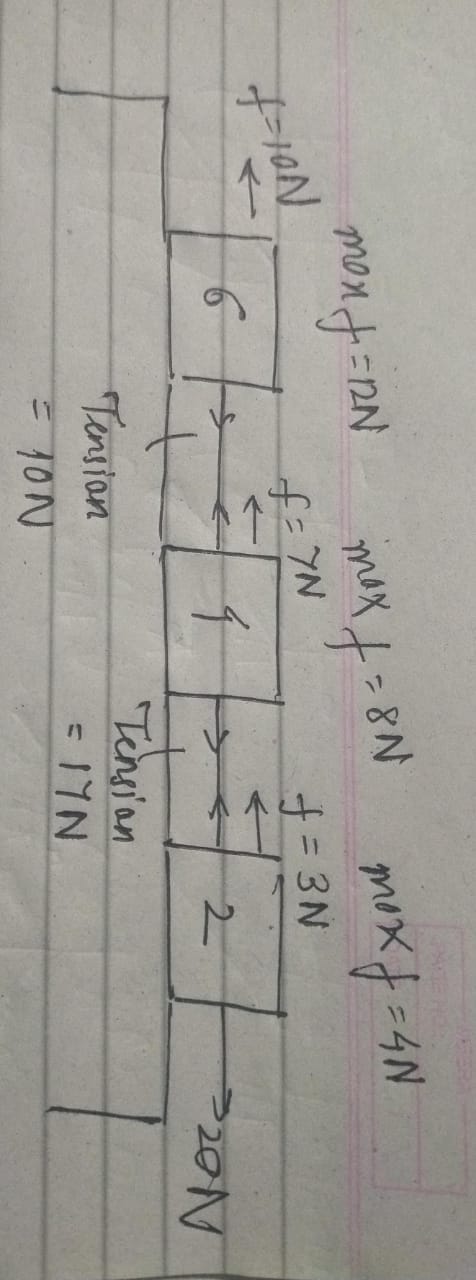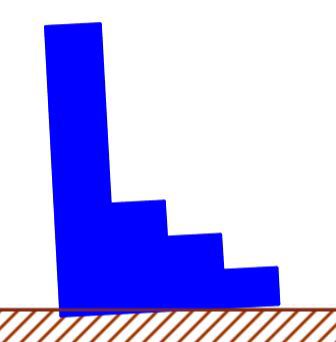For convenience I will label the blocks as $m_1, m_2, m_3$ from right to left to be consistent with the labeling of the tensions in you diagrams.
For simplicity consider a single block of mass $m$ sitting on a rough surface with a static coefficient of $\mu_s$, with a rope pulling the block to the left with a force of $F_R$ and another rope and an initially slack rope tied to something that is effectively static like a tree. For the block to start moving to the right we require $F_R > \ m \ g \ \mu_d $. When the block starts moving the static friction changes to dynamic friction $\mu_d$. Dynamic friction is usually lower than static friction and the force acting on the rope on the left is now $F_R - \ m \ g \ \mu_d $. As the block moves the rope tied to the tree straightens out and then the tension in the rope starts increasing until it is equal to the total force acting to the right ( $F_R - \ m \ g \ \mu_d $) and the block comes to rest when the net forces on the block are equalised. Now we have $F_R$ acting to the right on the block and $F_L + m g\ \mu_d $ acting to the left and the difference between the two forces is the dynamic friction $\mu_d$. Since the block has come to rest the static friction replaces the dynamic friction and provides the required difference. We can now see when a block with forces either side moves and comes to rest again the static friction is equal to the dynamic friction when the block was moving. This concept is explained in more detail in the answer I gave to the second question linked by Vincent in his answer. This principle applies to all the blocks in the chain that were moving at any point.
Dynamic friction is usually less than static friction and for the sake of argument, let's assume the dynamic friction is half the static friction so $\mu_d = \mu_s/2$.
Now let's consider the whole system. When the rightmost block starts moving and the rope to the left straightens out, the forces to the right acting on the middle block are $F_2 = F_R - m_1 g\ \mu_d$. Now by a similar process if there is sufficient force, the middle block starts moving and the total force acting to the right on the last block becomes
$$F_3 = F_R - \ m_1 \ g\ \mu_d - \ m_2 \ g\ \mu_d $$
$$\rightarrow F_3 = F_R - \ m_1 \ g\ \mu_s/2 - \ m_2 \ g\ \mu_s/2. $$
Putting in the numerical values of the question I end up with:

If the last block is heavy enough everything comes to a stop and the static friction of the leftmost block rises to match all the forces to the right. However, you might notice a problem in the diagram above. The last block is too light to provide sufficient static friction and in this case the whole system moves to the right. The reason my answer differs from the text book result, is that I have assumed extensible strings that allow the blocks to move one at time. The textbook seems to have assumed the block are absolutely rigidly connected by rods, (even though it mentions strings in the question and in the real world nothing is absolutely rigid) and that everything effectively behaves as a single rigid block.
In general for non-rigid connections, the difference in tension between the ropes on either side of a block is equal to the dynamic friction. For rigid connections, the difference in tension between the ropes on either side of a block is assumed to be equal to the maximum limiting static friction.
If you want to use infinitely rigid connecting rods and try to apply Young's modulus or Hooke's law to determine the tension in the rods you end up with indeterminate results and infinite rigidity doesn't really make much sense. However, we could imagine that if the blocks bend when a net force is applied to them, they could in principle transfer a force to the next block via a rigid rod without the base moving and in that case the assumed method used in the text book works using those assumptions which were not clearly stated in the text book question.







